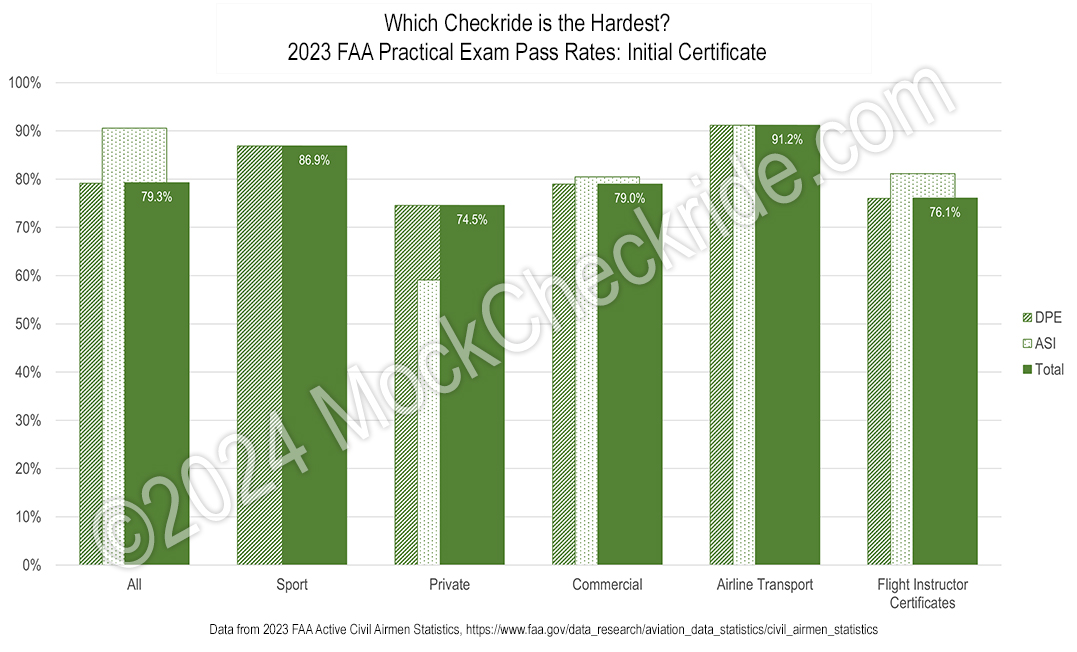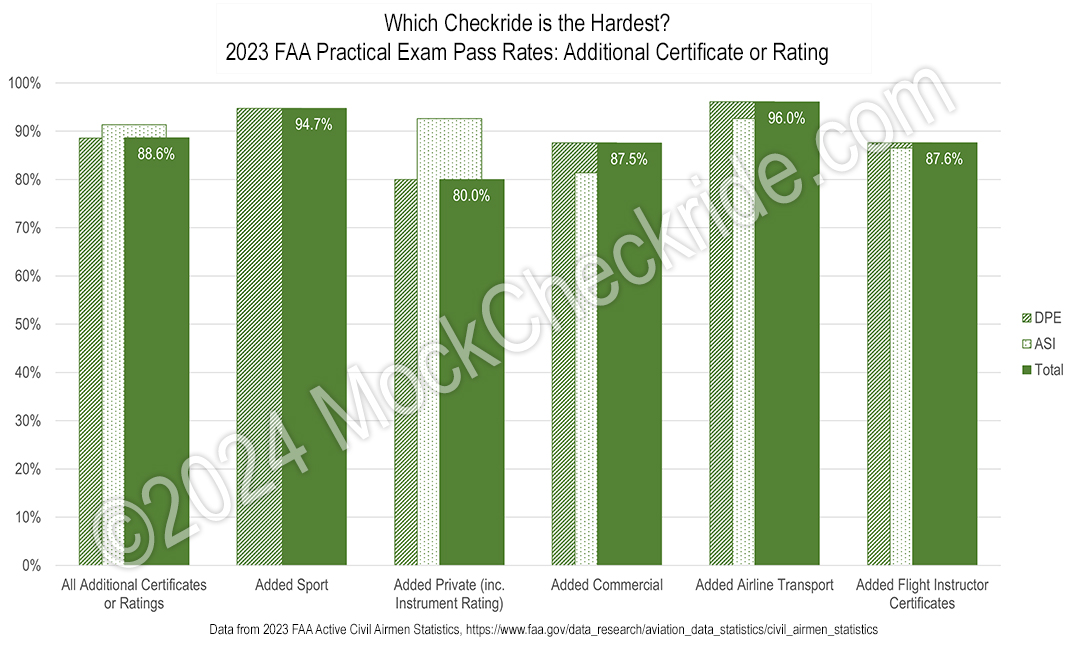2024 FAA Checkride Pass Rates

Published June 4, 2024
What’s the hardest checkride? What’s the average FAA practical exam (checkride) pass rate? What’s the pass rate for the Private Pilot checkride I’m about to take? Are Flight Instructor checkrides really failed as often as I’ve heard? Are add-on ratings (like Instrument) harder or easier than initial ratings? Does it matter if you take your checkride with a Designated Pilot Examiner (DPE) or an actual FAA Inspector?
We dug into the 2023 FAA Airmen Statistics to find out!
This post examines pass/fail rates. Obviously, the knowledge required for the Airline Transport Pilot (ATP) checkride is more complex than that needed for the Sport Pilot checkride, and the flying is much more demanding. So, at least in that sense, the ATP ride is “harder” than the Sport. However, the ATP ride is the least-failed of the standard FAA checkrides. Whether you interpret pass/fail rates as indicators of the degree of difficulty of any of these checkrides is up to you!
Since our focus here at MockCheckride.com is airplanes, this discussion is limited to airplane certificates and ratings.
Initial certificate pass rates

The first thing that jumps out is the overall FAA practical exam pass rate – 79.3% in 2023, down from 80.6% in 2022.
Secondly, the Private Pilot exam was failed most often of all exams (74.5% pass, 25.5% fail) in 2023. The flight instructor checkride is no longer the most-failed FAA practical exam (76.1% pass, 23.9% fail). Note that this is quite contrary to “urban wisdom,” which says the Private exam is one of the easiest checkrides to pass, and the Flight Instructor exam one of the hardest.
Many flight school hallways are filled with rumors of the Certificated Flight Instructor initial exam sporting a 50% (or even worse!) failure rate. That’s simply not the case, nor has it been for many, many years. Although approximately 1 out of every 4 candidates does fail, the CFI-Initial exam is not failed at nearly the rate you may have heard. The rate was basically unchanged in 2023 versus 2022; with a 23.9% fail rate in 2023, versus 23.8% in 2022.
The Sport Pilot initial and Private Pilot initial exams are very similar in content (and ACS/PTS evaluation standards), yet the Sport Pilot pass rate is significantly higher than the pass rate for Private. This same pattern showed up in our exploration of Knowledge Test Pass Rates. Are the instructors of Sport Pilots doing a better job in preparing their candidates? Are the candidates themselves of a different demographic, more likely to succeed for some reason(s)?
To the question of “Should I take my exam with an FAA Inspector if given the chance?” — our answer here is “it depends on the exam.” The overall pass rate for exams administered for pilot certificates by FAA Inspectors (90.5%) was higher than it was for DPEs (79.2%). The sample size was extremely small here; only just over 590 checkrides (at all pilot certificate levels) were administered by FAA Inspectors in 2023. At the Private Pilot level, DPEs passed more candidates (74.6%) than FAA Inspectors (59.1%). The Flight Instructor pass rate for DPEs (76.0%) vs. FAA Inspectors (81.1%) leaned toward the FAA inspector. Exams administered by FAA Inspectors are done at no cost (versus at a cost of hundreds or thousands with a DPE), so, given the similarity in pass rates, it would seem to be wise to take the FAA up on the offer should the opportunity ever arise.
Note that the FAA pass-fail statistics do not provide data on whether an exam was an initial take or a retake. Think about it this way. A group of 15 CFI candidates take their CFI-Initial exams at the same time. Of that group, 10 pass and 5 fail. The 5 that failed pass on their second try. The initial take pass rate is 66%, but the overall pass rate (what the FAA statistics document) is higher at 75%. This may also be affected in the other direction by a few poor candidates with multiple retakes. If 14 of those 15 passed on the first try (an initial take pass rate of 93%), and one applicant needed 6 total tries to pass, we’d still end up with the same overall pass rate of 75%. We believe that multiple failures are uncommon, so the initial take pass rate for any of these tests is likely to be slightly lower than the overall pass rate.
Additional certificate and rating pass rate

The FAA split out data for Additional Certificate / Ratings tables in their data release. This includes things like an Instrument Rating, a Commercial Multi-engine Add-on, a Type Rating for an ATP, or an Instrument Instructor add-on to a Flight Instructor certificate.
Overall, add-on rating checkrides featured a pass rate of 88.6%, 9% higher than initial certificate checkrides. Presumably, some of this can be attributed to the limited scope of many add-ons. A Commercial Multi add-on has fewer elements than a Commercial Multi initial; likewise for a CFI-Instrument done as an add-on versus a CFI-I done as an initial. Fewer elements = fewer chances to fail. This 88.6% rate represented a slight drop (1.1%) from 2022.
There is one glaring exception here – the Instrument Rating, which is an added rating, but as all instrument students (past and present) know, the Instrument Rating covers a substantial amount of material, and in many ways, is more demanding than an initial certificate. The Instrument Rating is not broken out from other Private Pilot additions in the FAA data. but it’s by far the most common, so it’s reasonable to assume the Instrument Rating pass rate is around 80% (20% failure rate).
Very few add-on checkrides are conducted by FAA Inspectors. The most common, add-ons to the Airline Transport PIlot certificate, were passed slightly less frequently when done with an FAA official (92.6%) versus a DPE (96.1%).
Long-term trends
This year, the Private failure rate finally eclipsed that of CFI. The trend since 2018 has had the failure rate gap narrowing between Private and CFI. The Private failure rate has varied from year to year over the past decade, but long-term, is around 23%. In the past years, it has increased to the current rate of 25.5%, a six-year high. The CFI failure rate has decreased dramatically during this same six-year window. Prior to 2018, the CFI failure rate hovered around 30%. For the past three years, that rate has been closer to 24%. Jason Blair covers this (and more) extensively here.
The Commercial failure rate has been steady at around 20% for the past three years. In the mid-2010s, the rate was higher, closer to 25%.
Overall test administrations were up significantly for 2023, continuing a upward trend evidenced over the past dozen years. 119,908 tests were administered in 2023, versus 94,309 in 2022 (this does not include other administrative actions). This is an increase of 27%.
Compared to 12 years ago, the workload of DPEs has more than doubled (Blair cites an increase from 60,621 actions in 2011 to 140,954 actions in 2023). The number of DPEs has remained roughly constant (944 in 2011 versus 969 in 2023).
Is it any surprise it’s becoming much more difficult to schedule exams?
Preparing for Your Checkride?
You’ll want to check out our free Checkride Prep Guide if you’re getting ready for your first FAA practical test.
Interested in why people fail practical tests? Here is a list of Common Deficiencies we see in mock oral exams for applicants preparing for their practicals.
A “mock checkride” with a third-party evaluator like MockCheckride.com is a great way to prepare for your upcoming checkride’s oral exam portion.
